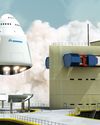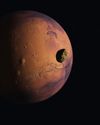THE HISTORY OF SPACESUITS: THE 60-YEAR EVOLUTION OF SPACE SURVIVAL TECH
All About Space UK
|Issue 140
These miniature spacecraft have allowed us to operate in space for over half a century

When the United States and the Soviet Union first decided to venture into the cosmos in the mid-20th century, it was readily apparent that they would need something to protect their explorers from the harshness of space. While pressure suits had been used before on high-altitude jets, no one was quite sure how the human body would cope with weightlessness, and particularly with the vacuum of space if a spacewalk was to be attempted.
One thing that was known for certain, however, was that exposure to space without a spacesuit would be fatal. 20 kilometres (12 miles) above Earth the atmosphere becomes so thin, and the atmospheric pressure is so low, that the water and blood in a human body will start to boil. Above this point, known as the Armstrong limit, some sort of protection is vital. Therefore the idea of a wearable spacecraft designed to protect its occupant from the harshness of space – now known as a spacesuit – was born.

Diese Geschichte stammt aus der Issue 140-Ausgabe von All About Space UK.
Abonnieren Sie Magzter GOLD, um auf Tausende kuratierter Premium-Geschichten und über 9.000 Zeitschriften und Zeitungen zuzugreifen.
Sie sind bereits Abonnent? Anmelden
WEITERE GESCHICHTEN VON All About Space UK

All About Space UK
MYSTERIES OF THE UNI WHERE ARE ALL THE SPIRAL GALAXIES?
There are far fewer spiral galaxies than elliptical ones in the Supergalactic Plane, and scientists are keen to discover why
7 mins
Issue 161

All About Space UK
ZOMBIE STARS
+10 OTHER TERRIFYING SPACE OBJECTS
8 mins
Issue 161

All About Space UK
HOW TO BEAT LIGHT POLLUTION
Thought it was impossible to observe the wonders of the night sky from towns and cities? Think again. Follow our tips and tricks on successfully observing through sky glow
2 mins
Issue 161

All About Space UK
15 STUNNING STAR CLUSTERS
These beautiful stellar groupings are spattered across the cosmos
8 mins
Issue 161

All About Space UK
Eileen Collins "It was a difficult mission...we were the first to see Mir"
Having served as both the first female pilot and first female commander of NASA's Space Shuttle, Collins boosted the involvement of women in space exploration to a whole new level
9 mins
Issue 161

All About Space UK
MARS LEAKS FASTER WHEN IT'S CLOSER TO THE SUN
The Red Planet has lost enough water to space to form a global ocean hundreds of kilometres deep
2 mins
Issue 161

All About Space UK
FUTURE TECH KANKOH-MARU
This ambitious reusable spacecraft will be capable of taking 50 people to and from orbit
2 mins
Issue 161

All About Space UK
THE FINAL FRONTIER
Beyond the reach of the Sun is a fascinating region of the cosmos that were only just beginning to explore
8 mins
Issue 161

All About Space UK
A long-lost moon could explain Mars' weird shape and extreme terrain
A long-lost moon could explain why Mars is so different from the other rocky planets in the Solar System. Today Mars has two tiny moons.
2 mins
Issue 161

All About Space UK
A sprinkling of cosmic dust may have helped kick-start life on Earth
Cosmic dust may have helped kick-start life on Earth. New findings challenge a widely held assumption that this wasn't a plausible explanation.
3 mins
Issue 161
Translate
Change font size

